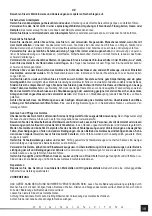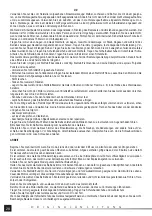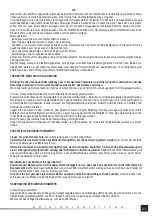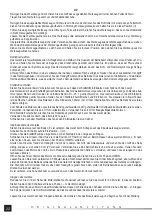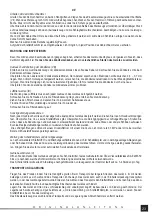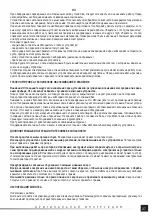
14
EN
O R I G I N A L I N S T R U C T I O N S
Regularly inspect the device according to the information contained in the further part of the instructions manual. This will allow
for more e
ffi
cient and safe work.
Take special care when handling the fuel. The fuel is
fl
ammable and its vapours – explosive. Observe the following points.
- Use canisters intended for fuel.
- Never remove the fuel
fi
ller cap or replenish fuel while the engine is running. Allow the engine and exhaust system components
to cool before refuelling.
- Do not smoke.
- Never refuel indoors.
- Never store the device or fuel canister in rooms where open
fl
ame occurs e.g. near water heaters.
- Do not attempt to start the engine if fuel is spilt; move the device away from the spill before starting.
- After refuelling, always close and tighten the fuel
fi
ller cap securely.
- Any emptying of the fuel tank must be carried out outdoors.
In case the blade hits any foreign object or the device starts to emit high-volume sounds, or vibrate abnormally, stop the engine
and wait until the device elements stop. Disconnect the cable from the sparking plug, and do the following:
- check the damage,
- check whether there are loose elements and tighten them,
- repair or replace all damaged parts with the parts compliant with the speci
fi
cation.
Wear safety glasses. The waste generated during work can create a risk of eye damage.
Read the instructions on stopping the device in case of emergency.
Before use, check whether the insertion tool, screws, guards, and other components are not worn or damaged. Replace worn
parts before starting work. Check also whether the screw connections are not loose. Tighten the loose screws.
OPERATION
Do not start work if you are tired, ill or under the in
fl
uence of alcohol or other intoxicating substances.
It is forbidden to work with the device in closed rooms. Fumes contain poisonous gases and inhaling them may pose a threat to
health and life.
It is forbidden to expose the device to precipitation and use it in an atmosphere of increased humidity. It is also forbidden to use
the device in an atmosphere with an increased risk of
fi
re or explosion.
Work only in daylight or in good arti
fi
cial lighting.
Always hold the device handles with both hands during operation. Another holding method may result in loss of control of the
device and cause serious injuries.
Use two-stroke engine fuel and oil which are free from solid impurities. Premium quality products are recommended. They will
extend the service life of the engine.
Avoid contact with grounded, conductive, and non-insulated objects such as pipes, radiators,
or refrigerators during operation.
Do not cover the ventilation inlets and outlets even when the device is not working.
Do not touch the engine surfaces that become hot during operation. This may cause burns.
Always wear suitable protective clothing adhering to the body. Use protective gloves and hearing protectors.
Keep the device’s handles clean and free of any oil or grease.
In case of
fi
nding any damaged or broken device parts, stop working or do not start working. It is essential to replace damaged
parts before starting work.
Use the device as intended. Use it for machining of surfaces made of ceramic or similar materials, e.g. concrete or stone. Do not
use the device for wood or metal machining.
Appropriately prepare a surface before starting work. Remove debris and objects that may damage the device or be ejected dur-
ing operation. Check that there are no electrical wires, water, gas or other pipes under the surface intended for work. Check that
there are no metal or wooden materials under the surface. For checking you can use detectors or read technical documentation
of the structure.
Stop the engine:
- every time you need to step away from the device;
- before cleaning, checking or repairing the device;
- after it being hit by a foreign object. Check that the device is not damaged and, if necessary, repair it before restarting,
- if the device starts to vibrate excessively (check immediately);
- during handling and transporting of the device.
Be always alert to your surroundings and possible hazards that you may not be aware of due to noise generated by the device.
The tool produces an electromagnetic
fi
eld of low intensity. The electromagnetic
fi
eld may a
ff
ect the work of electrical equipment
in the vicinity of the tool including pacemakers. Before starting work, it is recommended to consult a physician and/or a pacemaker
manufacturer.
Summary of Contents for YT-82138
Page 25: ...25 RU...
Page 26: ...26 RU 15...
Page 27: ...27 RU...
Page 28: ...28 RU II III 25 1 3 30 I IV OFF V ON 50 VI ON 3 5 24 24 3 5 O...
Page 29: ...29 RU VII VIII 0 6 0 7 IX 0 3 X SAE 20W 50 20 3 4...
Page 30: ...30 RU...
Page 32: ...32 UA...
Page 33: ...33 UA 15...
Page 34: ...34 UA II...
Page 35: ...35 UA IV III 25 1 3 30 I IV OFF V ON 50 VI ON 3 5 24 24 3 5 O O VII...
Page 36: ...36 UA VIII 0 6 0 7 IX 0 3 X SAE 20W 50 20 3 4...
Page 98: ...98 GR...
Page 99: ...99 GR 15...
Page 100: ...100 GR...
Page 101: ...101 GR II III 25 1 3 30 I IV OFF V ON 50 cm VI ON 3 5 24 24 3 5 O O...
Page 102: ...102 GR VII VIII 0 6 0 7 mm IX 0 3 MPa X SAE 20W 50 20 3 4...
Page 104: ...104 BG...
Page 105: ...105 BG 15...
Page 106: ...106 BG II...
Page 107: ...107 BG III 25 1 3 30 I IV OFF V ON 50 cm VI ON 3 5 24 24 3 5 O O VII...
Page 108: ...108 BG VIII 0 6 0 7 mm IX 0 3 MPa X SAE 20W 50 20 3 4...



















